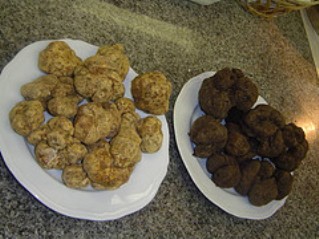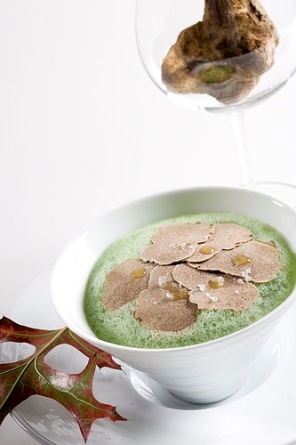As the nights draw in and the trees take on a golden hue, summer becomes but a distant memory. But what treats lie waiting in nature’s store cupboard, bring on the buried treasures that are a gourmet’s delight - truffles.
History of Truffles
For thousands of years truffles have been regarded as gems from the earth. The Ancient Egyptians munched away on truffles coated in goose fat. Even the extravagant Romans found them a luxury item. In the Middle Ages they fell out of favour as the all powerful clergy decided that their heady aroma was the creation of the devil and branded them ‘witches fare’. But by the time France’s Louis XIV was on the throne truffles were making a come back and as the king loved them they became fashionable for Parisian foodies of the time. Napoleon was reputed to have followed a special diet of truffle stuffed turkey and champagne in order to produce a male heir. And so he did.

Types of Truffles
The two big players of the truffle world are arguably the French Black Perigord truffle and the Italian White Alba truffle. There are several others including a few summer truffles, Chinese truffles and our own Oregon White but none of them compare in flavour and aroma to those two. The Black Perigord is referred to as the ‘Black Diamond of Provence’ can grow up to the size of an apple and has gray to black firm flesh and a powerful earthy flavor, selling for around $550 per lb. But top of the league we have the rarest and most fragrant Italian White with it’s smooth, yellowish skin and white to fawn flesh, often said to have a garlicky or shallot type flavor. Last year a white truffle weighing 3lb 4oz was auctioned off for $330,000.
Where Do Truffles Come From?
They form by fungi that grow under certain trees, such as pines, firs, oaks. Usually after a couple of weeks of heavy rain they swell just below the surface. In Italy the truffle collectors, or trufficulteurs to give them their proper name, have to be licensed and tested before they are let loose on the forests. They are often accompanied by a trained dog or a pig to sniff out the unmistakeable sweet, musty odor given off from the truffles. But as pig’s find them just as delicious as we do wrestling them from a pig’s mouth is no joke. It is said that you can tell who the local trufficulteur is by the missing fingers on their hands.

In the Kitchen
The white truffle, with its peppery flavor, is more perishable than its darker cousin and is eaten raw. What other ingredient can transform a humble plate of pasta or omelet into a gourmet dish with a few meagre shavings? While its black counterpart can be used in literally hundreds of ways apart from the classic partnerships of mashed potatoes, eggs, pasta, polenta and risotto. Why not try slipping some under the skin of a chicken before roasting. Slice a brie, open out like an oyster, add truffles, fold up and chill for 48 hrs and behold what a transformation. A simple potato salad can become a sublime extravaganza of a dish with an introduction of truffles and a day in the refrigerator. With such an expensive ingredient nothing can be wasted. Use the peelings in stocks, soup and sauces. Take a bottle of mild oil and add what truffles you can spare for future aromatic drizzling. Store them next to eggs or uncooked rice and these will take on their pungent aroma. Should you have any left over freeze in oil or fat. But if you really find them an extravagance too far, why not try bought in truffle tapenade or baste your meat with truffle honey or even add truffle paste to cream for a scrumptious speedy sauce. And to finish off the meal serve a truffle truffle with coffee. A truffle flavoured chocolate available from urbanitruffles.com. Julia Child said “use as many truffles as you can afford” and we can’t argue with that.
Photos courtesy of Bernardus - Flickr